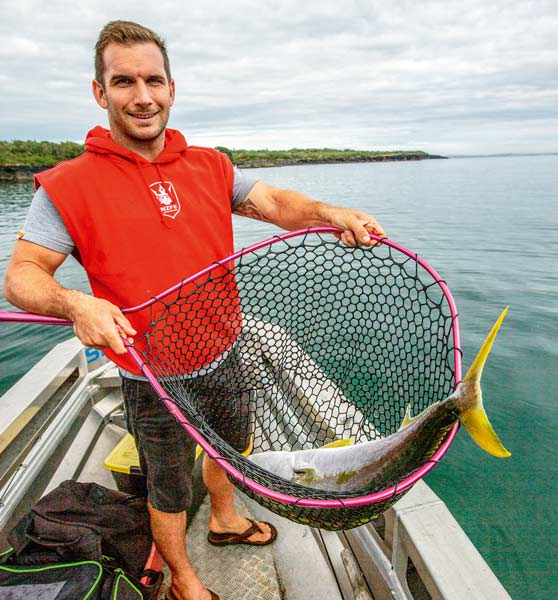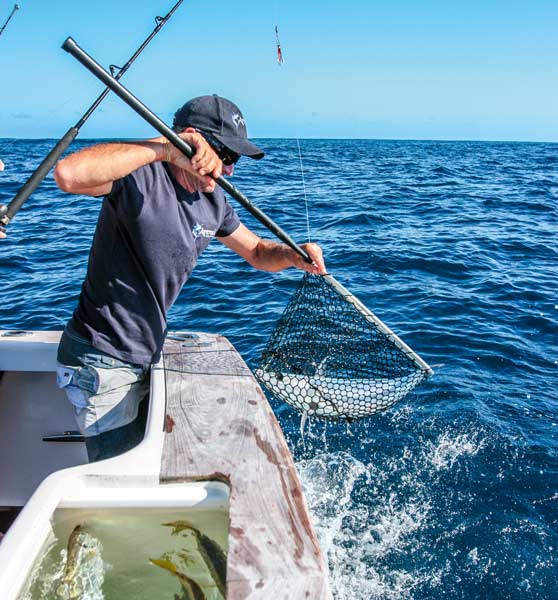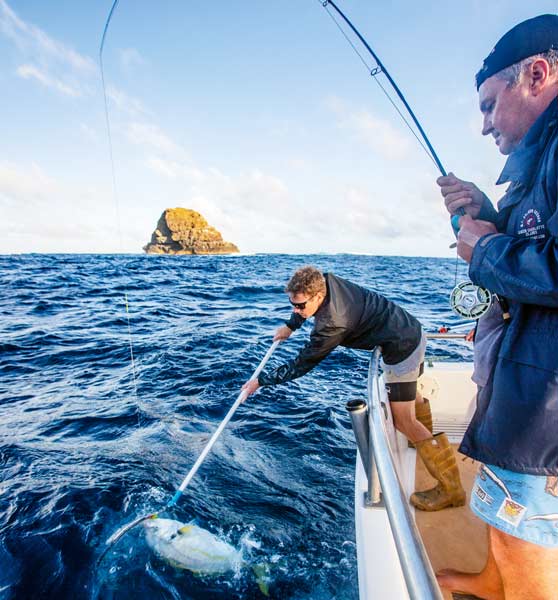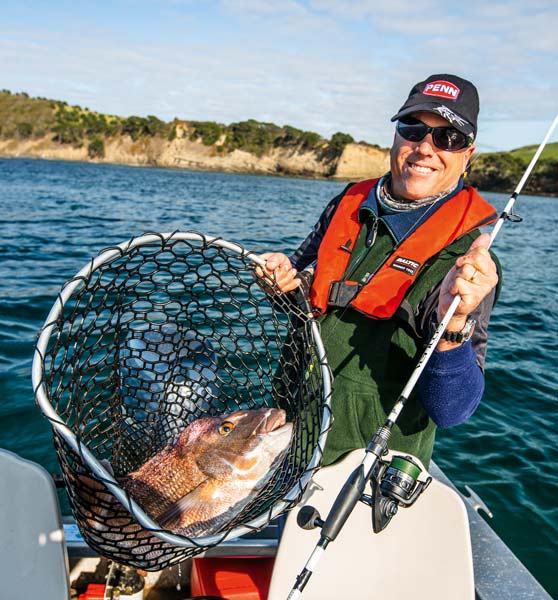Netting or gaffing your catch (Part 1)
I only have a 14-foot (4.3m) tinny, so generally don’t get out very far, but I always carry a decent-sized landing net and a gaff because both have important roles to play. On the whole, a net is easier to use, so it’s common sense to look at that option first, especially if you’re mostly targeting snapper. However, every now and then most fishers encounter large kingfish, either deliberately targeted or incidental by-catch, and then the gaff becomes invaluable.
Let’s look at nets first…
Some situations suit a net better than a gaff:
- When the fish is not huge (i.e. less than 10kg, say), but the leader could snap while lifting them on board
- When the fish is lightly hooked or is a species known for having a soft mouth (i.e. john dory, skipjack tuna and trevally)
- When you must control and contain the fish, especially active fish such as kahawai and kingfish, to safely remove the hook/s
- When you want to avoid injuring the fish as much as possible, perhaps so you can release it or weigh it in for contests and records – using a gaff causes blood and weight loss
- Fishing in a freshwater situation where gaffing is illegal.

Which net?
The net type you choose should depend on the role it will play and how it is stored. Nets can be folding, collapsible, telescopic or fixed – or combinations thereof. Many boats with limited storage or fishing space often go for collapsible, folding or telescopic nets, but moving parts may seize, corrode or break, so I have opted for a large, fixed-head Berkley model with a long handle.
This net’s an absolute ripper, with a light but reasonably strong aluminium frame and a generous rubber-meshed net bag with enough circumference and volume to accommodate the biggest snapper, as well as kingfish up to around 12 or 13 kilos. I like the fact this model’s net bag can be replaced if it becomes badly damaged, but mine’s still in reasonable shape after five or six years’ hard use.
There are rubber nets available with tighter mesh, but this adds weight and makes them harder to drag through the water, which is a disadvantage when you’re trying to secure lively fish.
There are also landing nets with nylon-meshed bags. The more expensive models with soft-mesh net bags aren’t too bad. They inflict minimal damage the protective slime and scales that cover a fish’s body, leaving fish destined for subsequent release in reasonable shape. Cheaper ones, however, made of coarse, unforgiving nylon are rough on fish.
Woven mesh net bags of any material tend to snag hooks and fins, making the landing/releasing process slower and sometimes very frustrating.
Another net component to take notice of is the metal of the hoop or frame. Stainless steel is very strong and resistant to corrosion, but heavy to wield, especially when the net is fully extended (along with the angler’s arms!).
Aluminium is much lighter and also corrosion resistant, but bends and snaps more easily.
Whatever the net’s made of, choose the longest handle you can stow in the boat. Many people simply put up with the hassle of a long-handled net that’s difficult to stow because a long handle can make the difference between a trophy fish and another painful story of the ‘one that got away’.
A reasonably soft but hard-wearing grip or two on the handle is a good idea, as bare metal can be slippery to hold. Most grips are made from EVA.

Netting strategies
- Make sure the net is close to hand before starting fishing; leaving it buried deep in the hold or under mountains of gear in the bow till you need it can be costly.
- Hastily swiping or plunging the net at the fish may end up knocking it off the hook or see another hook caught in the mesh, preventing the fish from being netted afterwards. Instead, be patient and wait until the fish is up on or near the surface, heading at you headfirst. Then, just as the fish comes within range, place the net down in front of its head and smoothly scoop it up. Conversely, avoid trying to net fish tail first as they simply swim away or out of the net again.
- When using an aluminium net on a big fish, avoid hoisting them on board too horizontally. Instead, angle the net downwards so less leverage is being exerted, perhaps also holding one side of the net hoop to add extra support.
- Nets provide some degree of catch containment, so it generally pays to leave fish in them while unhooking, especially if they are to be released afterwards; hot decks and dry hands see fish heading off looking healthy, but cause burns that get infected and often lead to death several days or even weeks later. Don’t needlessly waste our resource.

It’s also worth remembering that nets are much easier for inexperienced anglers to use, but once fish get over 12 or 13 kilos, you’ll probably need one, and that’s the subject of next month’s article.
|
----- Advertisement -----
|
This article is reproduced with permission of |
Fishing Reports Visit Reports
Bream Bay Fishing Report - 18/04/24
Change in seasons, change in tactics Not a lot to report in the ‘big fish’... Read More >
Canterbury Fishing Report - 04/04/24
Fish galore! Coming off the back of Easter Weekend and with some very nice weather... Read More >
Raglan Fishing Report - 04/04/24
Excellent snapper action There is some excellent autumn snapper fishing straight out and up the... Read More >
Bream Bay Fishing Report - 04/04/24
Whangarei Harbour fishing well Like the weather, the fishing has been patchy throughout Bream Bay... Read More >





Comments